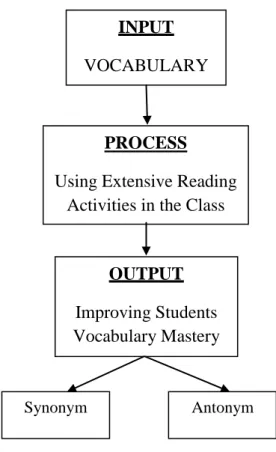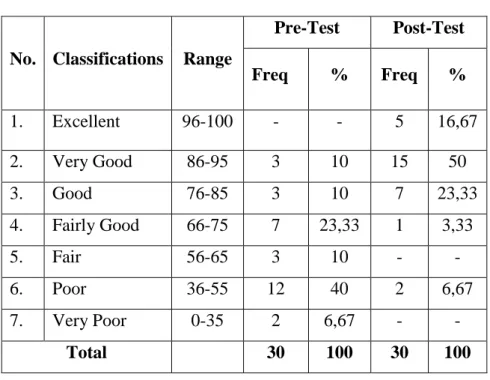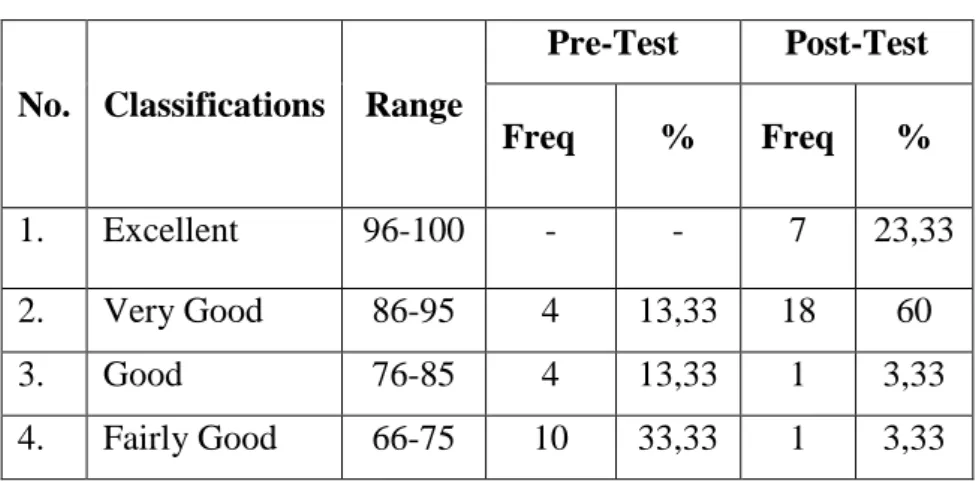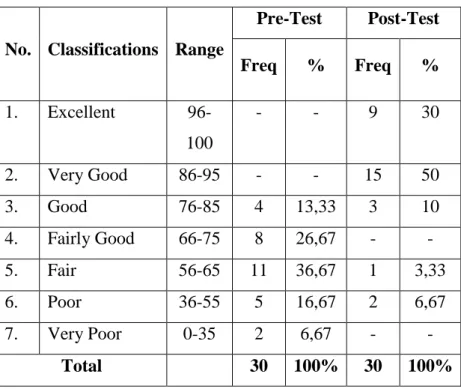Judul Skripsi: The Effect of Extended Reading Activities on Improving Vocabulary of Tenth Grade Students of SMA Negeri 4 Takalar (A Pre-Experimental Study). The Effect of Extended Reading Activities on Improving Vocabulary of Tenth Grade Students of SMA Negeri 4 Takalar (A Pre-Experimental Study). It is also said that the null hypothesis (H0) is rejected and the alternative hypothesis (H1) is accepted. The result of the data showed that extensive reading activities improved the students' vocabulary.
Terdapat pengaruh yang signifikan penggunaan aktivitas membaca ekstensif terhadap peningkatan kosakata siswa di kelas sepuluh MIA 3 SMA Negeri 4 Takalar. Pengaruh kegiatan membaca diperpanjang terhadap peningkatan kosakata siswa di kelas sepuluh SMA Negeri 4 Takalar (studi eksperimental).
INTRODUCTION INTRODUCTION
Background
In teaching reading in a foreign language, an extensive reading approach allows students to read as much as possible. In addition, Blair (2011) points out that extensive reading helps students build their vocabulary, familiarizing them with words and parts of language skills, and. Extensive reading has the added advantage of students choosing their own text, which generally increases their motivation and confidence and creates a more positive attitude towards reading and language learning.
Based on the above statement, the researcher decided to apply Extensive Reading Activities as a method to improve students' vocabulary. Therefore, the title of the research is "The effect of extensive reading activities on improving the vocabulary of students in the tenth grade of SMA Negeri 4 Takalar".
Problem Statement
Objective of the Research
Significance of the Research
Scope of the Research
In this chapter, the researcher presents the previous related research results, the concept of vocabulary, the concept of extensive reading, the conceptual framework and research hypotheses.
Previous Related Research Finding
- Word of Vocabulary
- Types of Vocabulary
- The Important of Vocabulary
- Principles for Teaching Extensive Reading
- Procedure of Extensive Reading in the Classroom
- The Role of Extensive Reading in Language Learning
In other research, Chen et al (2013) have investigated on "The effect of extensive reading via e-book on EFL students' reading attitude, reading comprehension and vocabulary at tertiary level". Endah (2014) researched on "The Effectiveness of Extensive Reading into Students Vocabulary Mastery" the result showed that there was effectiveness of Extensive Reading in relation to students' vocabulary mastery. Seno and Yonemoto (2014) investigated whether "Vocabulary Learning Through Extensive Reading" the results show that Extensive Reading is particularly beneficial in consolidating students.
Example words are vegetable which has a general meaning while carrot is more specific. Second, word meaning is also governed by metaphors and idioms, e.g. the words hiss refer to the sound of a snake and one's threat to others. Here are some activities to implement the extensive reading program proposed by Fanshao in Sudirman (2016).
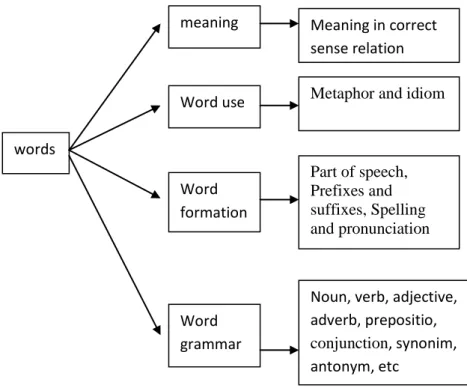
Conceptual Framework
Research Hypotheses
RESEARCH METHOD RESEARCH METHOD
Research Design
- Pre-test
- Treatment
- Post-test
- Sample
The treatment is: the researcher introduces and explains the extensive reading and vocabulary (synonyms and antonyms), the researcher can ask his student about the stories they have ever read, the researcher distributes the reading material, the students choose the reading material based on what want to read, the researcher invites the students to read and understand the material in a silent way, after reading, the students do a reading about the material, the researcher conducts a group discussion for the students based on the same reading material, after the discussion, they can present the discussion of the result in front of the class, then the researcher invite students to learn and understand synonyms and antonyms based on the given task, the last Students receive a reward from the teacher. After the treatment, the students were given a post-test to determine the improvement in the students' vocabulary. A test score was calculated to measure whether or not students achieved.
The population of the research was the first year students of SMA Negeri 4 Takalar in the academic year 2018/2019. The researcher took one research sample, specifically X MIA 3, which consists of 30 students. The researcher used purposive sampling because it was the best technique in ensuring the representativeness of the sample from the accessible population.
Variable and Indicator 1. Variable
- Indicator
The indicator of comprehensive reading activities improving students' vocabulary was identifying specific synonyms and antonyms.
Research Instrument
Procedure of Data Collection
Technique of Data Analysis
The researcher takes data to know the population in the tenth grade of SMA Negeri 4 Takalar. The table above meant (1) that the t-test value is less than the t-table value, the null hypothesis is accepted while the alternative hypothesis is rejected and (2) the t-test value is equal to greater than the t-table value, the null the hypothesis is rejected and the alternative is accepted. This research chapter discusses the research findings and discussion of the findings.
The findings presented in this work consist of data obtained from a test on the improvement of students' vocabulary through extensive reading activities.
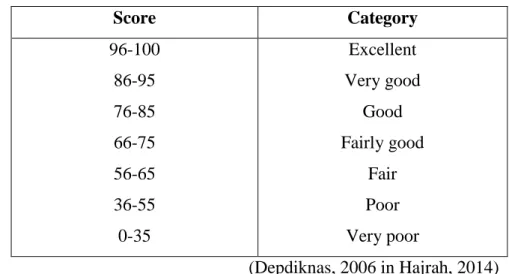
The Findings
- The Improvement of the Students’ Vocabulary in Term of Synonym
- The Improvement of the Students’ Vocabulary in Term of Antonym
- The Students’ Rate Percentage and Frequency in term of Synonym
- The Students’ Rate Percentage and Frequency in term of Antonym
- The Students’ Rate Percentage and Frequency in Vocabulary of the Pre-Test and Post-Test
The above table indicates that there is an improvement in the students' vocabulary in term synonym from pre-test to post-test, which in pre-test of the students means score performance in synonym 59.07, but after giving a treatment the students' vocabulary in term synonym becomes 86.64. Therefore, the improvement of students' vocabulary in term synonym from pre-test to post-test is 46.67. The above table indicates that there is an improvement in the students' vocabulary in term synonym from pre-test to post-test, which in pre-test of the students means score performance in synonym 64.80, but after giving a treatment the students' vocabulary in term synonym becomes 87.97.
Therefore, the improvement of the student's vocabulary in terms synonymous from the pre-test to the post-test is 35.75. The student's achievement in terms of vocabulary improvement through extended reading activities during the pre- and post-test was shown as follows: The table above shows that the frequency and percentage of the student's vocabulary in terms synonyms differ between the pre-test and post-test.
This means that the students' vocabulary in terms of synonyms can improve through Extended Reading Activities. The table above shows that the frequency and percentage of the students' vocabulary in termantonyms differ between pre-test and post-test. The students' rate percentage and frequency in vocabulary of the pre-test and post-test of the pre-test and post-test.
The table above shows that the frequency and percentage of the students' vocabulary are synonymous. After calculating the student's pre- and post-test result, the student's standard deviation. The table above shows the average score and standard deviation of the students during both the pre- and post-test.
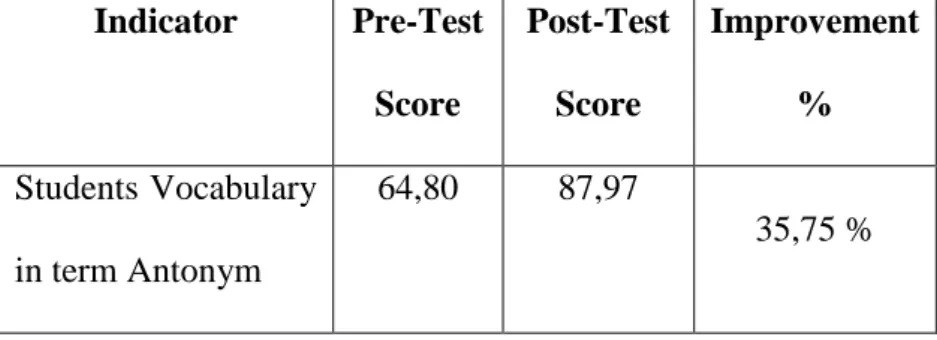
Discussions
The improvement of students' vocabulary performance by using extensive reading activities had an effective effect. The researcher found that before the application of Extensive Reading Activities, the students' pre-test mean scores in synonym fair classification. However, after using Comprehensive Reading Activities, the students do very well in the post-test.
The students thought that teaching vocabulary through the use of Extended Reading Activities was very helpful in improving their vocabulary. Therefore, the use of Extended Reading Activities in this research had a great influence on the students' vocabulary because it can help the students to improve their vocabulary in term synonym. Students' vocabulary in term antonym this is supported by the average score of the students on pre-test and post-test.
There is improvement before and after the application of the Extended Reading Activities. The students thought that teaching vocabulary through the use of Extended Reading Activities was very helpful in improving their vocabulary. Therefore, the use of Extended Reading Activities in this research had a great influence on the students' vocabulary because it can help the students to improve their vocabulary in term antonym. Considering the data analysis and the discussions in the previous chapter, the use of Extended Reading Activities at Tenth Grade MIA 3 of SMA Negeri 4 Takalar is effective in improving the students' vocabulary performance.
This is evidenced by the average score of the students before the test and the post-tests which differed significantly. This shows that the average score of the student on the pre-test was 62.83 (fair), while the average score on the post-test was 87.27 (very good). In addition, the t-test value of the students' vocabulary improvement was greater than the t-table value.
Suggestions
For future researchers, this research can be used as a reference to apply Extensive Reading Activities. It is a convenient reference to apply to improve students' vocabulary in synonym and antonym terms. Improving students' vocabulary mastery through extensive reading activities in class XI IPA 2 of SMA N 1 Pleret Bantul in the academic year 2011/2012. Diploma thesis.
Reading beyond the textbook: Why extensive reading is. https://www.fremmedspraksenteret.no/nor/fremmedspraksenteret/lari ngs-ressurser/leseveileding-i-engelsk/reading-beyond-the-. textbook/why-extensive-reading-is-important_, accessed 15 May 2018) Chen, C. Tertiary EFL Students' E-Book Reading, Reading Attitude, Reading Comprehension and Vocabulary. Turkish Educational Technology Online Journal. Using Word Attack in Developing Vocabulary Mastery for Aliyah Bulu Lampang DDI Mangkoso Barrru Second Year Students.
The effect of extensive reading and intensive reading on Iranian EFL learners. Depth of vocabulary. Journal of Language Teaching and Research Rosalez, Riant. Effective Vocabulary Instruction (Online), (http://www.keystoliteracy.com/wp-.content/uploads/2012/08/effective-vocabulary-instruction.pdf, accessed May 15, 2018).
Mathcing the words that agree with their synonym of the right column !
Mathcing the words that agree with their antonym of the right column !
KI-2 : Menghidupi dan mengamalkan perilaku jujur, disiplin, santun, peduli (gotong royong, gotong royong, toleran, damai), bertanggung jawab, tanggap dan proaktif dalam interaksi yang efektif sesuai dengan perkembangan anak di lingkungan, keluarga, sekolah. , masyarakat dan lingkungan alam sekitar, bangsa, negara, kawasan regional, dan kawasan internasional. KI-3 : Memahami, menerapkan, dan menganalisis pengetahuan faktual, konseptual, prosedural, dan metakognitif berdasarkan rasa ingin tahu tentang ilmu pengetahuan, teknologi, seni, budaya, dan humaniora dengan pengetahuan tentang kemanusiaan, kebangsaan, kewarganegaraan, dan peradaban terkait penyebab fenomena dan peristiwa, serta serta penerapan pengetahuan prosedural pada bidang studi tertentu sesuai bakat dan minatnya untuk memecahkan masalah. KI-4 : Elaborasi, penalaran dan penyajian dalam lingkup konkrit dan abstrak berkaitan dengan pengembangan apa yang dipelajari di sekolah secara mandiri, bertindak efektif dan kreatif serta mampu menggunakan metode sesuai kaidah ilmiah.
Kompetensi Dasar
Indikator
Langkah-langkah Pembelajaran a. Kegiatan Awal
Media/Alat Buku cerita
- Synonym
- Antonym
- The Improvement of the Students in term Synonym P =
- The Improvement of the Students in term Antonym P =
Vocabulary
- Vocabulary
